Customer experience (CX): Definition, benefits, and resources to improve it
Explore customer experience, understand its importance, and generate continuous data that you can use to improve it. Want to survey your customers now?

Customer experience (CX) is how customers perceive every interaction with your organization, encompassing every touchpoint, including your advertising, team, products, and more. These myriad interactions, numbering in the hundreds or even thousands, shape how customers feel about your business. Consequently, measuring customer experience is imperative for your organization, as it builds loyalty, fuels growth, and enhances profitability.
Keep reading to fully explore how to measure and improve customer experience, or skip ahead to one of these topics:
- Customer experience definition
- The importance of customer experience
- How to measure customer experience
- Customer experience survey questions
- How to improve customer experience
- Customer experience quick tips and resources
Customer experience definition
Let’s take a few steps back. As previously noted, customer experience (CX) is informed by the overall impression a customer has of your company based on all their interactions with you—from the first ad they see from your business to how you engage with seasoned customers.
Measuring and monitoring the customer experience will help you find obstacles in the customer journey. By improving CX, your customers will feel more satisfied, increasing revenue and boosting loyalty.
The importance of customer experience
The customer experience is one of the single most important aspects of running a business. Without customers, your company can’t generate profit or experience growth. Equally, if you only have unhappy customers, you’ll experience higher rates of churn.
Here are just a few of the benefits of a great customer experience:
- Boosted customer loyalty: Customers who enjoy their CX with your brand are more likely to return.
- Better customer engagement: Customers who enjoy your business are more likely to engage across all touchpoints—and more frequently.
- Higher customer satisfaction: A high rate of customer satisfaction will help convert your audience into loyal customers. Promoters are more likely to recommend your brand to their colleagues and friends.
Many statistics validate the importance of CX:
- SurveyMonkey research demonstrates that 88% of customers who receive a poor experience lose trust in that brand.
- We’ve also discovered that 57% of people have permanently stopped using a product after just one bad experience.
- The SurveyMonkey State of CX report found that 91% of consumers are likely to recommend a company after a positive experience.
Yet, despite the vast range of benefits, only around 20% of companies have a comprehensive CX program. Most businesses still need more organizational support to improve the customer experience, and many are unsure how to measure customer experience.
To give clients what they’re looking for, you have to get systematic. You’ll need to continuously collect feedback from every customer, analyze their responses, and share them across the team so they can take action.
How to measure customer experience
To measure customer experience successfully, you’ll need to be thoughtful about how you collect feedback and what questions you ask in your surveys. Companies use several ways to measure customer experience, each with its own set of pros and cons.
Measure the customer experience with surveys
Surveys are a quick, easy, and efficient way of collecting customer data. By establishing a Voice of the Customer (VoC) program, your company can begin to record a range of metrics that closely link to overall customer satisfaction. This program includes a range of useful surveys you can run to better understand the customer experience.
Surveys are some of the most common methods for measuring CX: one questionnaire can gather thousands of responses, making short work of measuring large groups of customers.
Pros:
- They’re cost-effective: The cost of sending a survey to your customer base is exponentially cheaper than other, more resource-consuming options.
- They’re scalable: Surveys give you the power to interview huge portions of your customer base—or even all of them!
- They’re actionable: You collect responses in an organized, straightforward way to interpret and make decisions. From there, you can take varying actions.
- They’re trackable: Measure how your responses are changing over time to uncover larger insights and trends.
- They’re automated: Using SurveyMonkey for CX, you can automatically set parameters that trigger your survey’s delivery.
Cons:
- Resources: Setting up a consistent CX survey program takes significant time, headcount, and financial investment. CX pros must prove the ROI of a good customer feedback program to demonstrate its worth.
- Commitment: Customer experience success won’t happen overnight. Businesses need to be willing to commit to a strategy with sufficient resources for long-term development.
- Follow-through: Businesses need to request feedback from customers who report a poor experience. This additional step lets customers feel heard and helps your business identify critical areas for improvement. Don’t overlook feedback follow-through, and remember to close the feedback loop.
Interview individual customers
If you want to get detailed, in-depth feedback from the people you rely on for your business, there’s no better way than to talk to them directly. It may seem time-consuming, but direct contact with customers can be well worth it.
Pros:
- It’s comprehensive: You can ask them as many questions as you want (within reason) about whatever you want to get in-depth feedback about your customer's expectations, needs, and pain points.
- It builds rapport: A face-to-face interaction with a customer helps them become more familiar with you and your organization, which likely increases their loyalty to your brand.
Cons:
- It’s costly: It can take up a lot of resources (in both time and money spent) to schedule and hold customer interviews.
- It involves just a sample of your customers: You'll receive feedback from a small set of individuals who voice their opinions the loudest. As a result, there’s a chance that your product roadmap and strategy could move in the wrong direction.
- It can be difficult to manage: In most cases, maintaining a customer-interview program is a full-time job, which means you’ll need dedicated resources to make it work.
One weakness to this strategy is that the customers most likely to want an interview will likely be your biggest supporters. Without a fair range of sample answers, you might miss out on key criticisms and areas of improvement.
Conduct focus groups
Focus group discussions tend to be more free-form than surveys or direct interviews, which are usually scripted. You don’t even have to get everyone in the same room to have a focus group—you can hold the meetings over video conference or on the phone.
Pros:
- It allows customers to learn from each other: The chance to hear how others work with you can inspire customers to use your product/service in new ways.
- It can promote dynamic and engaging conversations: With a variety of different perspectives, the conversations can take unexpected and insightful turns.
Cons:
- Requires a trained moderator: Focus groups need a moderator with extensive training to facilitate useful and insightful conversations.
- Data is difficult to analyze: Focus groups can produce a great deal of data. However, this data mostly comes in the form of anecdotes that are hard to analyze. Equally, identifying individual opinions from the group can pose a challenge.
- The sample may not be representative: Focus groups need to be small to facilitate a productive conversation. Yet, this small group may not accurately represent your wider audience, leading to bias and unrepresentative data.
These approaches to collecting feedback should complement your analysis of financial data points. These include your churn rate and your average customer lifetime value (CLV).
What are the best customer experience surveys and metrics?
Due to the number of potential touchpoints a customer will have, it can be overwhelming to know where to start measuring CX.
There are many different types of surveys to collect customer feedback at all critical touchpoints. When choosing which touchpoints to focus on, consider these important customer experience metrics. Below, we’ll explain how to measure and use each of them.
Net Promoter Score® (NPS)
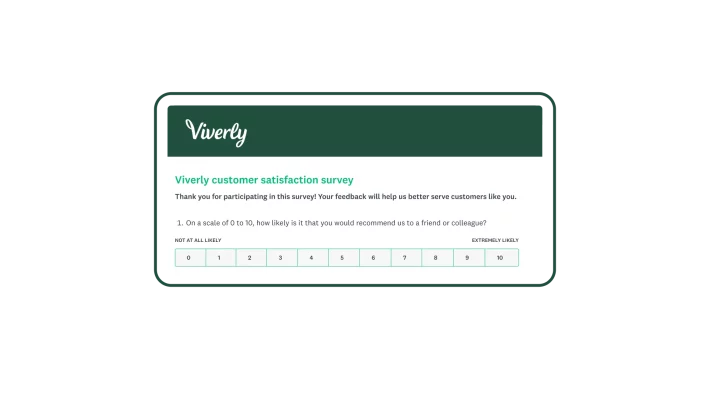
The most widely used customer experience metric is the Net Promoter Score. It helps understand everything from the likelihood that customers will churn to the chance they’re willing to buy additional products or services. NPS is the leading metric for determining customer loyalty.
Your business can use different NPS types:
- Relational NPS: Measuring the customer experience at specific time-based intervals. This type of NPS measures a customer’s general loyalty and satisfaction over time.
- Transactional NPS: Following a defined set of customer experiences, like after a customer makes a purchase or speaks to a service representative. This form of NPS gives feedback and insight into how a customer feels during an interaction.
An NPS survey asks the question, “How likely is it that you would recommend this company to a friend or colleague?” But you can also apply it to products, services, or company interactions.
Respondents select a rating from 0 (lowest) to 10 (highest). Using the responses, you can calculate your NPS score, ranging from -100 to +100.
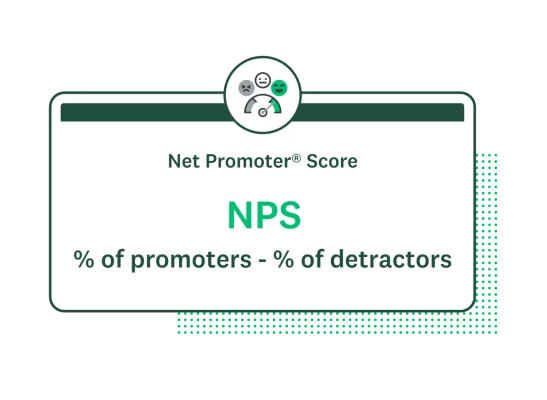
As the NPS score is benchmarkable, you can compare your business to others in your industry.
Pro tip: If you use the NPS question in our Question Bank, SurveyMonkey will automatically calculate your score once the responses come back.
Customer Effort Score (CES)
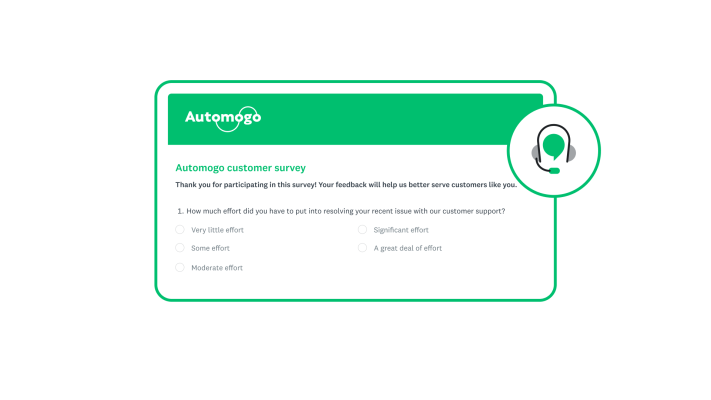
Customer Effort Score (CES) measures how much effort the customer needs to exert to solve issues with your product or service. The idea is that the less friction customers experience with your product or service, the more likely they are to stay on and increase their level of spending.
In general, CES evaluates specific types of experiences in the customer journey. These points are also known as “transactional touchpoints.”
To evaluate your Customer Effort Score, you can ask, “[Your company] made it easy for me to handle my issue,” with the answer choices ranging from strongly agree to strongly disagree. You can then assign numerical values to each choice. For instance, “Strongly agree” can be a 1, “Agree” can be a 2, “Neither agree nor disagree” can be a 3, and so on.
You can then calculate your CES score from all of your answers, where a higher average rating reflects a higher level of effort for customers.
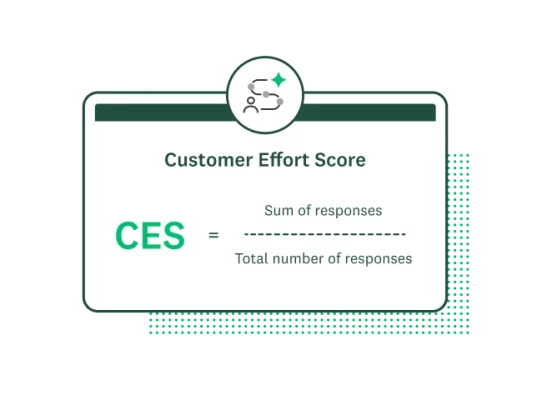
Customer Satisfaction Score (CSAT)
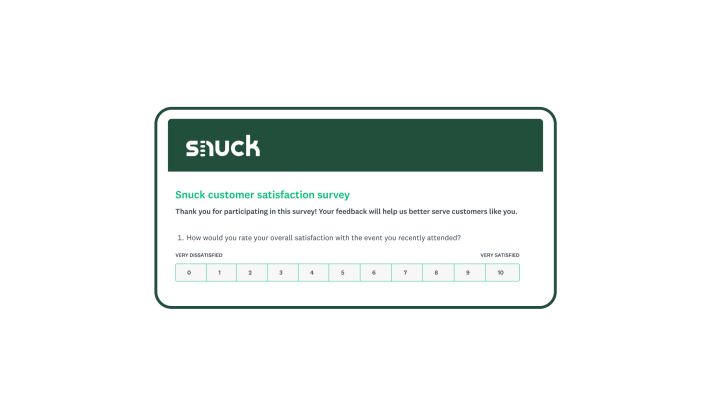
The CSAT score measures customers’ overall sentiment in relation to a product, company, or service. Instead of focusing on a specific element of the customer experience, like loyalty or effort, it attempts to get a holistic read of customers’ feelings about an issue.
The most common way to ask about general customer satisfaction in a CSAT survey is to ask, “How would you rate your experience with our (fill in the blank)?” with the answer choices ranging from very satisfied to very dissatisfied.
To get your CSAT score, take the number of satisfied customers (those who selected “very satisfied” and “satisfied”) and divide it by the total number of respondents. Then, multiply the fraction by 100 to give you a percentage. A higher percentage means that, all else equal, you have more satisfied customers!
Purchase & transaction surveys
Purchase feedback surveys measure satisfaction across your purchase experience. Considering that 82% of consumers have canceled a purchase due to a poor purchase experience, streamlining your transactions is vital.
A purchase satisfaction survey will help you better understand how your customers feel about transactions with your business. By identifying pain points, you can enhance and streamline your purchase pathway.
Transaction surveys use the Likert scale to allow respondents to select an opinion that closely matches their own. You can ask questions like “The price was fair” or “I was able to use my preferred payment method” with a range of options as responses.
Collecting purchase data allows you to measure the effectiveness of your purchase process. Combining this with open-ended questions allows you to find areas you can improve upon to increase customer satisfaction and streamline sales.
Customer service surveys

Customer service surveys measure the performance of your customer service team. They assess whether your team can solve problems quickly and effectively. Customer service teams that help customers solve their problems contribute to higher rates of overall customer satisfaction.
Around 90% of consumers state that customer service is an important factor in their favorite brands. Monitoring and improving this metric over time can help enhance the customer experience and forge better customer relationships.
A customer service feedback survey will range from general questions about satisfaction with customer service to questions that assess whether the support agent solved the problem quickly.
Use the results from this service to identify issues with your customer support team and outline how to remedy them. As your customer service team improves, your customers will feel more supported by your business.
Event surveys

Event surveys measure attendee satisfaction after a webinar, forum, or in-person event. You can use the data from an event survey to determine how successful the event was and find areas where you can improve.
After hosting an event, these surveys will help you identify whether or not your customers were satisfied and felt like you organized the event well. Typically, an event feedback survey will ask questions like, “How friendly was the staff?” and “Was the event length too short, too long, or about right?”
Event survey data can help make your events better than ever. Collecting data and creating actionable insights from customer feedback will chart your pathway toward more effective events.
How to improve customer experience
The customer experience your business offers impacts everything from your custom churn to your bottom line. With that in mind, improving CX should be at the top of your list of priorities.
Let’s explore how to improve customer experience in three simple steps.
Build a customer-centric culture
Data is at the heart of every improvement your business can make. Using customer insight from data collection, you can pinpoint areas for positive iteration. But, if you want data to significantly impact your organization, you need to embed it into the workplace culture.
Here’s a step-by-step guide to building a customer-centric culture in the workplace:
- Leadership commitment: Before enacting a culture change, you need support from leadership. Top leadership can champion these changes and ensure that customer-centricity becomes central to the company’s vision and values.
- Employee engagement: Educate your employees about why you’re creating a customer-first culture. Demonstrate how each team can use customer data to deliver exceptional customer experiences.
- Empowerment: Democratize access to data to give every employee the tools they need to succeed.
- Training: Provide ongoing training to enhance employees’ skills in customer-centric problem-solving, communication, and customer support.
- Feedback mechanisms: Implement customer feedback programs to capture customer insights. Respond to feedback and take action to satisfy customers and improve your customer touchpoints.
- Cross-functional collaboration: Prioritize cross-department collaboration to break down data silos and provide a seamless customer experience.
- Measure performance: Establish customer experience-related key performance metrics (KPIs) to measure the effectiveness of your customer experience strategy. Measure metrics related to VoC, like NPS, CSAT, and CES.
- Rewards and recognition: Reward employees who demonstrate exceptional customer-centric behaviors. This approach will reinforce the importance of customer-first service in your business.
- Continuous improvement: Measure, evaluate, and continuously refine your customer-centric practices. Adapt to changing customer needs and market trends to stay ahead of competitors.
Creating a customer-centric culture allows your business to provide an enhanced customer experience. Prioritizing a data-first approach will empower your employees to give your customers the best possible service.
Every interaction with customers produces data. With a customer-centric culture at the helm of your organization, your employees will understand the value of turning this data into insight and action to improve.
Benchmark your progress
One of the most useful aspects of creating a data-driven culture is that you can track improvements over time. By continually collecting data and comparing it to previous samples, you’ll discover how your business is changing.
The more data you have, the more opportunities you have to benchmark your data. You can benchmark:
- Against other companies: Benchmarking against your close competitors will help you identify areas where you can provide a better customer experience.
- Against industry averages: Finding industry-wide benchmark statistics for churn, customer satisfaction, or another metric will help show how your company compares. Generate a benchmark report to assess your performance against others.
- Against your internal data: Frequently recording customer data will help you trace how your changes are impacting customer satisfaction.
Customer satisfaction survey benchmarks are vital for monitoring your business's progress over time. They help quantify your positive improvements and demonstrate that you’re moving in the right direction.
Act on feedback
Collecting feedback is one thing; responding to it is another. One way of letting your customers know that you’re actively working on improving is to close the feedback loop. Where possible, reach out to customers who left feedback and let them know you’re taking their comments seriously.
Depending on the type of feedback you receive, you can respond differently. Here’s a quick guide:
- Positive feedback: Thank the respondents for their comments and their trust in your business. Outline potential methods they can use to recommend your business to a friend.
- Neutral feedback: Reach out to the respondent and ask for more details, suggesting that you’d be happy to improve a process to give them a better experience with your brand.
- Negative feedback: Thank the customer for their honesty and outline the steps you are taking to remedy their problem. If possible, detail the timeframe in which you expect your company to fix the issue.
Closing the feedback loop lets your customers know that their comments are important to your company. This customer experience strategy helps improve customer satisfaction, boost loyalty and customer advocacy, and create a feedback culture where individuals are more inclined to leave comments.
Related reading: How to follow up with NPS detractors, promoters, and passives
Customer experience quick tips and resources
Running a customer feedback program involves several moving parts. If your company has only just begun to invest in your customer experience, it can seem overwhelming.
Here are some quick tips and resources you can use to get more information on how to effectively improve your customer experience:
- Understand customer experience trends: Read through the SurveyMonkey state of CX research report to learn about current market trends and identify how you can make the most of them.
- Put customers first: Creating a customer-centric culture won’t happen overnight, but it is one of the most impactful ways of improving CX.
- Learn from the best: Explore other great customer experience examples to learn how other companies approach CX. Seeing CX in action will help your company form a more precise action plan to improve your own customer experiences.
- Discover more competitors: Your industry and close competitors will directly inform how your business engages with its customers. Use SurveyMonkey Audience to get a comprehensive understanding of your competitors' landscape.
- Don’t forget about your employees: A winning customer experience is closely connected with happier employees. Improving the employee experience will help to boost customer satisfaction.
Ready to make your customer experience even better?
Net Promoter, Net Promoter Score, and NPS are trademarks of Satmetrix Systems, Inc., Bain & Company, Inc., and Fred Reichheld.
Discover more resources

Solutions for your role
SurveyMonkey can help you do your job better. Discover how to make a bigger impact with winning strategies, products, experiences, and more.

8 Benefits of Customer Feedback Surveys for Your Business
Discover 8 key benefits of customer feedback surveys. Improve customer experience, retention, and decision-making to stay competitive.

C-suite secrets: Smart strategies for tough times
Hear from industry leaders on how they're facing current business challenges and driving impact

Voice of the cruiser: Hornblower's CX playbook
How to use feedback to create an impactful cx program